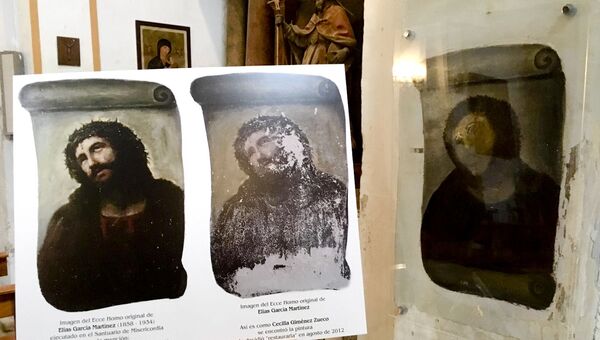The sculpture of a female adorning the ornate façade of an office building in Palencia, Spain has drawn the attention of netizens after a local resident pointed out the controversial results of its recent restoration. The sculpture's face was deformed as if it had been made to look like a strange cartoon character rather a woman, and was soon dubbed by one netizen as the "potato head of Palencia".
While mishaps like the one that took place in Palencia are relatively rare, they often prompt people to scratch their heads, wondering how anyone could do such a thing to a work of art. Even the most known and iconic creations are seemingly not protected from such a fate. Here are the most famous and notorious cases of restoration efforts going wrong.
Gluing Tutankhamun Back Together
The mask of Ancient Egyptian Pharaoh Tutankhamun had survived for thousands of years in the tomb, but it was damaged in an unspecified 2014 incident that left its "beard" broken off from the face. However, instead of hiring professionals, the Museum of Cairo apparently delegated the tricky task of piecing the pharaoh's mask together again to one of its employees, who simply decided to attach it with epoxy.
While the beard was put back in its rightful place, the epoxy used in the repair work was now not only distinctly visible where the detached piece had broken off from the face, but also on Tutankhamun's chin. The worker was unable to find a better solution than to peel it off with a metal spatula… along with the layer of gold covering most of the famous mask.
Concrete-Clad Great Wall of China
The legendary Great Wall of China continues to slowly deteriorate despite its status and the efforts of Beijing to preserve the piece of cultural heritage. Yet, while some parts of the wall enjoy increased attention in terms of maintaining the structure’s condition, others do not. A portion of the wall near the border between Liaoning and Hebei provinces is apparently among the latter, as those behind the 2014 restoration efforts simply decided to cover the top of the wall with a layer of concrete instead of restoring its numerous stairs made of stone. It is unclear how much of the wall was lost due to the efforts of the workers, who were later accused of damaging the cultural site.
Fluffy Jesus
While the fresco "Ecce Homo" (“Behold the Man”) by Spanish artist Elias Garcia Martinez in the Sanctuary of Mercy Church in Borja, Spain was originally not very famous, it became known to the entire world in 2012 after a local 80-year-old amateur restorer, Cecilia Gimenez, decided to lend a helping hand to the deteriorating piece of art.
The result of her work was far from ideal. The image of Jesus Christ depicted apparently grew a layer of fur instead of hair and, as some netizens joked, looked more like a "monkey" than a "man", let alone the Messiah.
A More Modern Version of St George?
The five-century-old wooden sculpture of St George in a church in the Spanish town of Estella met a similar fate after a local priest ordered to have it cleaned. Those behind the restoration apparently thought their artistic freedom was broader and practically repainted the sculpture in new and bright colours, deforming the saint's face along the way.
The Long Hand of the Proletariat
An image of the leader of the Great October Socialist Revolution in Russia, Vladimir Lenin, also fell victim to the creative interpretation of a restorer who worked on a statue of him in the Krasnodar region in Russia. The restorer not only changed his face beyond recognition, but also altered one of his arms, making it unlike anything seen among humankind. Despite an abundance of conspiracy theories surrounding Lenin's life, none have suggested that he was an alien, thus the inspiration behind the restorer's work on the statue of the leader of the Russian proletariat remains a mystery.
Deformed Faces All Around
Three sculpted faces of the Roman god Mercury have long adorned the façade of a century-old trading house in the centre of Moscow on Myasnitskaya Street designed by the architect Fyodor Schechtel. But when one of the masterpieces was in need of restoration in 2015, the result looked nothing like the original. In fact, some of Moscow’s residents suggested that the restorer had imagined the Roman god differently from most others, apparently looking at the new look of the eyes and the new form of the deity's nose.
A Change for Better or Worse?
Not all restorations that have drastically altered the original look of a piece of cultural heritage are universally deemed bad or evil. One of the most prominent cases is the rebuilding of the crumbled Castle of Matrera near Villamartín in Spain. Those behind the renovation chose to use modern concrete to rebuild the destroyed parts of the building instead of imitating the original materials. At the same time, they preserved the remaining parts of the stone walls, which look like they "cover" a more modern building.
While local residents condemned the restoration as destroying the spirit of the original building, some members of the expert community actually valued the idea of showing the contrast between the historic and modern parts of the building.





